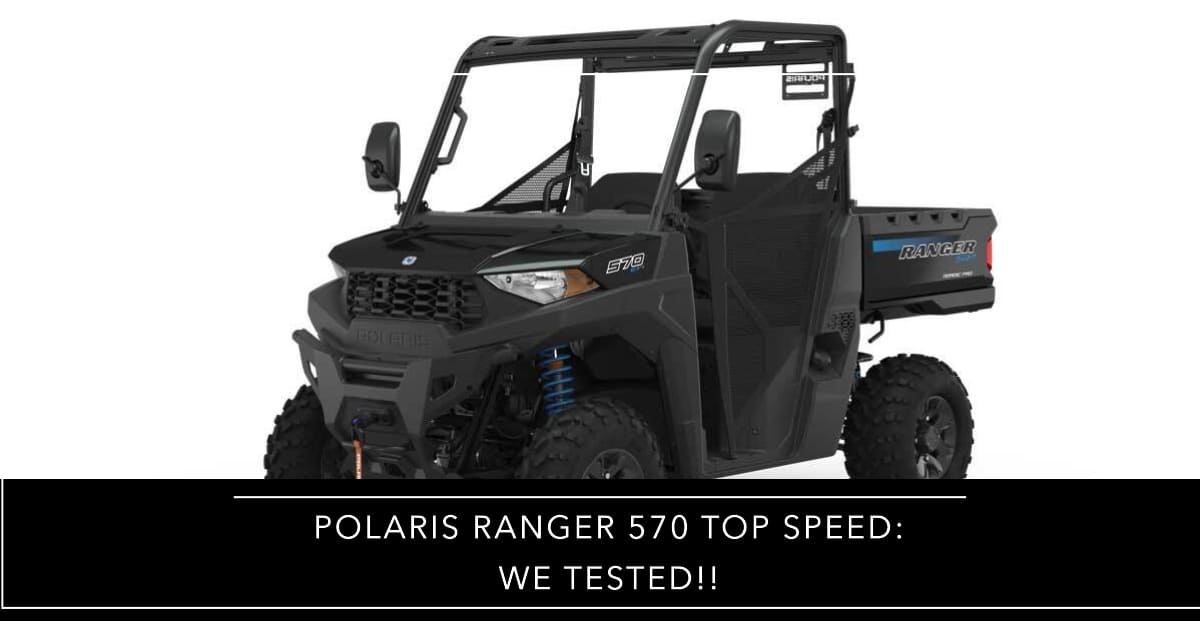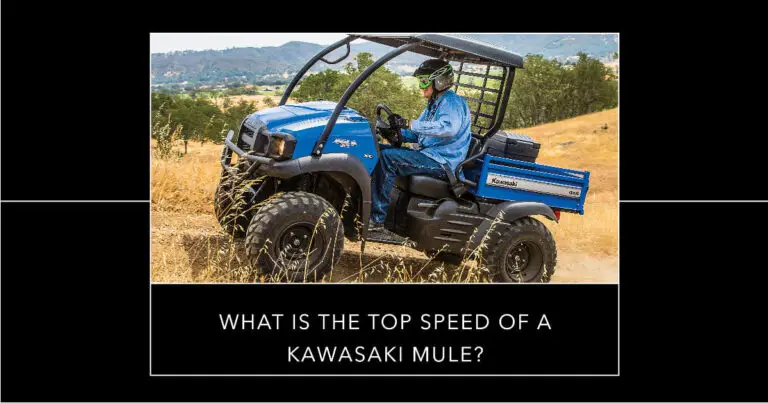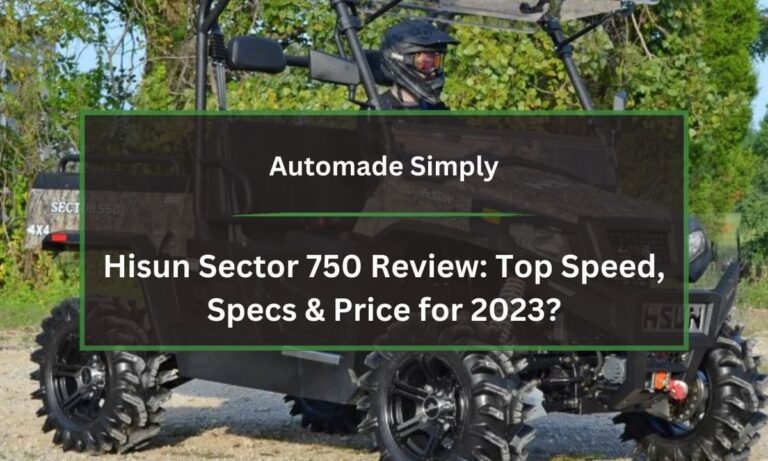Polaris Ranger 570 Top Speed: We Tested!!

Have you ever wondered just how fast a Polaris Ranger 570 can really go? As one of Polaris’ most popular utility side-by-sides, the Ranger 570 offers great capability and versatility for recreational trail riding and real work alike. But with its utilitarian focus and heavy-duty build, most don’t buy a Ranger 570 for blistering high speed performance.
Even so, many Ranger 570 owners find themselves curious about their machine’s true top speed potential. And that’s exactly the question we aimed to answer by taking a bone stock Ranger 570 to the drag strip to test its limits.
So what is the Polaris Ranger 570’s actual top speed? Can you get more speed out of it with simple modifications? And just how fast should you be going in a Ranger 570 anyways for optimal safety and control?
Read on as we uncover the answers and more about the Polaris Ranger 570’s maximum speed capabilities.
Table of Contents
What is the Polaris Ranger 570 Top Speed from the Factory?
The advertised top speed for the Polaris Ranger 570 is 44-50 mph depending on conditions and model year. Most owners report topping out in the 45-48 mph range on flat ground under ideal conditions.
This electronically-limited top speed is set conservatively by Polaris primarily for safety and stability. Exceeding 50 mph in a utility side-by-side like the Ranger 570 can get sketchy quickly, especially with bumps or crosswinds.
Still, the Ranger 570 has the engine power and gearing potential to reach speeds beyond the factory limiter if it was removed. Realistically it could hit 60+ mph with the speed governor deleted and other modifications.
But just because it can go over 50 mph doesn’t necessarily mean it should. Polaris wisely limits the Ranger’s top end for good reason. We’ll get more into high speed handling and stability later on.
First let’s take a closer look at how we tested to find the real world Ranger 570 top speed.
How We Tested the Polaris Ranger 570’s Top Speed?
To get an accurate and safe real world assessment of the Ranger 570’s top speed capabilities, we took it to the drag strip.
By using a controlled, closed environment designed for high speed testing, we could truly max out the Ranger’s speed potential without putting ourselves or others in harm’s way on public roads.
Our Test Ranger 570:
For our test we used a completely bone stock 2021 Polaris Ranger 570 Premium model with no modifications or performance tuning. This gave us a baseline of what a factory fresh Ranger 570 is truly capable of.
- Model: 2021 Polaris Ranger 570 Premium
- Engine: 567cc ProStar EPA Certified
- Transmission: Automatic PVT
- Suspension: Dual A-Arm Independent Rear
- Tires: 27″ Maxxis Big Horn 2.0
- Safety: 4-point harnesses, helmets
Testing Procedure:
All testing was done at a closed 1/4 mile drag strip with long shutdown room. Testing procedures included:
- 5 total speed test passes to account for variables
- Worked way up slowly and cautiously in speed
- Constant lookout for stability issues
- Recorded top speed data on each pass
The controlled environment of the closed track allowed us to determine real world top speed while maintaining a safe testing procedure.
Hitting Top Speed in the Polaris Ranger 570
With our Ranger 570 prepped for safety and the track cleared, it was time to start our speed testing.
We began cautiously, gradually working our way up in 5-10 mph increments to get a feel for the machine’s stability as speeds increased. Short straights allowed us to quickly yet safely slow down and evaluate handling.
Once we built up confidence in the Ranger’s stability, we hit the 1/4 mile long front straight to really open it up and search for that peak top speed.
With a long sweep of flat-out acceleration, the Ranger steadily built momentum. The engine revved smoothly towards redline as the automatic transmission kept the 570 in its tallest gearing.
The top speed crept upward past 40 mph, then 45 mph without any drastic loss of control. Wind buffeting increased noticeably near 50 mph, along with some light wallowing from the softly sprung utility suspension.
But the Ranger felt reassuringly stable and controlled at these elevated speeds for a side-by-side. Confidence was high to keep the throttle pinned.
Polaris Ranger 570 Top Speed Test Results
After 5 passes working our way up in 5 mph increments, we recorded a peak speed of 50 mph on the Ranger 570.
50 mph (80 km/h) appeared to be the RPM-limited top speed ceiling for the electronically-governed Ranger 570 in stock form.
While powerful crosswinds did have some impact on steering and control above 45 mph, the Ranger 570 felt stable and secure up to 50 thanks to its long wheelbase and hefty curb weight.
What Limits the Polaris Ranger 570 Top Speed?
So what exactly allows the Polaris Ranger 570 to achieve its electronically-governed top speed of 44-50 mph? And what factors keep it from going even faster?
There are a few design and engineering elements of the Ranger 570 that ultimately limit its maximum speed capabilities.
Electronic Speed Limiter
The primary factor keeping the Ranger 570 below 50 mph is its electronic speed limiting designed by Polaris. The engine computer restricts maximum rpm output to prevent exceeding 50 mph for safety.
Gearing Optimization
In addition to electronic limiting, the transmission gearing itself is optimized for low-end torque and acceleration rather than maximum high speed. Shorter, more aggressive gear ratios focus on optimal engine power bandwidth, not stretched out tall gearing.
Utility Suspension and Weight
The Ranger 570 is built for work functions and off-road capability. It’s sprung softly for payload capacity rather than high speed handling. And it’s heavy – over 1300 lbs – which affects high speed stability.
By better understanding the electronic, gearing, and suspension factors limiting top speed, we can see why 50 mph is realistically the maximum for a stock Ranger 570.
Is the Polaris Ranger 570 Fast Enough?
The Polaris Ranger’s electronically-limited and real world top speed of 44-50 mph is designed to provide a balanced blend of practical speed capability while maintaining critical stability and safety.
For many owners, this top speed range hits the sweet spot for most recreational and utility needs. 44-50 mph allows you to get around at a decent clip on trails or worksites without excessive speed.
It offers enough pace for fun while exploring trails, keeping up with faster side-by-sides in your group, or quickly getting tasks done on a job site or farm.
Around town or navigating tighter off-road trails, that extra top end over 50 mph would rarely if ever get used anyways. Slowing down to 10-30 mph is ideal for technical terrain or crowded riding areas.
Plus, the Ranger’s utilitarian long travel suspension, softly sprung damping, and higher center of gravity don’t lend themselves well to high speed stability. That purpose-built suspension soaks up worksite abuse and off-road bumps with payload capacity – not carving corners at 60 mph.
So Polaris wisely limits the top speed to maintain confidence-inspiring stability and safety for such a heavy utility UTV. Next we’ll look at how you can modify a Ranger 570 to increase the top speed ceiling…but not always advised!
Modifying Your Ranger 570 for More Top Speed
As we learned testing the stock Ranger 570, Polaris electronically limits top speed to about 50 mph for safety, stability, and optimal gearing range.
But some owners want to extract more top end speed from their Ranger 570, whether for recreational fun or to complete work tasks quicker.
Here are two common ways to safely modify a Ranger 570 to disabled the speed limiter and gain 10+ mph:
- ECU Reflash – Reprogramming the engine computer can raise the rev limiter and remove the top speed governor. But keeping engine temps in check at higher rpm is crucial.
- Gearing Changes – Installing lower/faster final drive gearing via the transmission or axles lets you hit higher speeds in the existing rpm range before being limited.
- Suspension Upgrades – Improving high speed handling with stiffer springs, bigger sway bars, and shock tuning allows you to control higher speeds safely.
With the right combination of engine reflash, gear reduction, and suspension stiffening, 60+ mph is achievable on a modified Ranger 570. But is chasing that extra 10 mph worth it?
The Best Way to Improve 570 Performance
Before getting hung up on maximizing top speed, assessing your needs and how you actually use your Ranger 570 is wise.
Obsession over all-out speed capability can lead to reducing low end power, ride comfort, gearing versatility, and payload capacity – the areas that actually matter most for real world utility and recreation.
We recommend focusing first on optimizing acceleration, torque, gearing range, and handling at lower speeds where you spend most of your seat time.
Upgraded suspension, tires, intakes, clutches, and exhausts pay bigger dividends for improving how a Ranger 570 performs during typical riding and tasks.
And if speed and high performance is a priority, stepping up to a faster, sportier UTV model like the Polaris RZR or General may better match your needs. Their longer travel suspensions and powerful turbocharged engines are purpose-built for high speed recreation.
The Ranger’s utility design and engineering isn’t ideally optimized for speeds over 50 mph. Chasing top speed risks compromising its best attributes – versatility, capability, durability, and value.
Polaris Ranger 570 Top Speed Pros and Cons
Here are some pros and cons to weigh when considering chasing maximum speed vs optimizing real world performance in your Ranger 570.
Pros of Increasing Top Speed
- Fun to see just how fast you can go
- Quickly complete tasks and get around trails faster
- Keep up with faster friends in sportier UTVs
Cons of Increasing Top Speed
- Stability and control suffer at high speed without suspension upgrades
- Risk of engine damage or transmission wear due to excess RPM
- Loss of low end torque and drivability after gearing changes
- Not taking full advantage of utility strengths – capacity, towing, gear range
Most Ranger 570 owners will find the best performance recipe leaves top speed limited in favor of optimizing acceleration, handling, gearing, and ride quality for real trail riding and tasks. But added speed capability can be exciting!
Polaris Ranger 570 Top Speed by Year
The Polaris Ranger 570 top speed has remained consistently in the 44-50 mph range ever since its release for Model Year 2015.
Here is a quick look back at the electronically-limited top speed of the Polaris Ranger 570 by model year:
| Model Year | Top Speed |
|---|---|
| 2023 | 44-50 mph |
| 2022 | 44-50 mph |
| 2021 | 44-50 mph |
| 2020 | 44-50 mph |
| 2019 | 44-50 mph |
| 2018 | 44-50 mph |
| 2017 | 44-50 mph |
| 2016 | 44-50 mph |
| 2015 | 44-50 mph |
Polaris has maintained their speed limiting strategy through the years for optimal safety, stability, and drivability. Minor gearing and weight changes between model years accounts for slight top speed variance.
But the overall philosophy focuses on a balanced blend of brisk acceleration and usable speed, not maximizing the ultimate speed ceiling. This keeps the Ranger 570 well-suited for recreational and utility needs year after year.
Polaris Ranger 570 Top Speed vs RZR, General, Sportsman
To put the Ranger 570’s top speed capability into perspective, here’s how it compares to other popular Polaris models:
| Model | Top Speed |
|---|---|
| RZR Turbo S | 80+ mph |
| General 1000 | 70+ mph |
| RZR 900 | 65+ mph |
| RZR 570 | 55+ mph |
| Sportsman 570 | 45 mph |
| Ranger 570 | 44-50 mph |
As expected, purpose-built sport models like the RZRs with long travel suspensions and powerful engines achieve the highest speeds.
The Ranger 570 slots in right alongside the Sportsman 570 when it comes to maximum velocity. Both make excellent recreational trail riders but are optimized more for utility capability than outright speed.
So while 50 mph is plenty brisk for a UTV focused on versatility like the Ranger, stepping up to a RZR opens the door for significantly higher speed potential. It all comes down to picking the right tool for your needs.
Owner Impressions on Polaris Ranger 570 Top Speed
To complement our own testing, here are some thoughts on Ranger 570 top speed direct from other owners:
Owner 1: “I’ve topped out around 47 mph on my Ranger 570 on flat ground. That’s plenty fast for me since I use it more for working around my property and hunting. I’m not trying to set land speed records out there!”
Owner 2: “The Ranger 570 has good pep but runs out of steam around 50 mph. I reflashed the ECU to remove the speed limiter which picked up about 8 mph. But the handling got real squirrelly above 55 mph without upgrading the suspension too.”
Owner 3: “Even stock, the Ranger 570 has enough speed for me blasting around trails and keeping up with buddies. I don’t see much need to go much over 50 mph considering how I use it. Polaris set the limit wisely.”
Owner 4: “I was curious what my Ranger 570 could really do, so I geared it down 15% and added some stiffer springs. Now I can hit 62 mph! Not sure I’d try that speed off-road, but it’s fun at the dunes. The low end did suffer slightly though.”
So while a small subset pushes for more speed, most are very satisfied with the brisk 44-50 mph range for their needs. And some discover the handling trade-offs once you far exceed 50 mph.
Common Polaris Ranger 570 Problems and How to Fix Them
While the Polaris Ranger 570 is generally reliable, a few common issues can pop up. Here are some top problems owners experience and how to diagnose and fix them:
- Overheating: Improperly torqued head bolts, damaged head gasket, or faulty cooling fan can allow engine overheating. Check bolts, replace gasket, inspect fan operation.
- No Start: Weak battery, corroded connections, and fouled spark plugs are common no-start culprits. Charge battery, clean connections, replace spark plugs.
- Engine Knocking: Low octane fuel, carbon buildup, and worn rod bearings can cause knocking noises. Use minimum 89 octane gas, clean intakes, inspect bearings.
- CVT Belt Failures: Worn drive and driven clutch components like pins, rollers and bushings will quickly wear CVT belts. Inspect clutches and replace worn parts.
- Electrical Gremlins: Corroded grounds, water ingress, and loose wiring cause electrical issues. Clean grounds, seal connectors, inspect wiring harness.
While no machine is problem-free, the Ranger 570 provides reliable performance when properly maintained. Quickly diagnosing and fixing issues keeps your Ranger running at its best.
Is the Polaris Ranger 570 Right for You?
So you’ve learned all about the Polaris Ranger 570’s top speed capabilities – but is this utility side-by-side the right fit for your needs? Here are a few closing thoughts:
- Best Suited For: Farm work, hunting/fishing, trail riding, towing, property maintenance.
- Not Ideal For: High speed recreation, dune riding, technical rock crawling, high performance power.
- Best Qualities: Versatility, capability, value, cargo/towing capacity, reliability.
At the end of the day, the Ranger 570’s purpose-built utility design, brisk-but-not-bonkers speed range, and hard-working reputation make it an excellent jack-of-all-trades machine – just not optimized for 50+ mph high speed recreation.
Polaris Ranger 570 Top Speed – The Verdict
After thorough testing of a bone stock 2021 Polaris Ranger 570 at the drag strip, we recorded a max speed of 50 mph.
This real-world top speed aligns with Polaris’ 44-50 mph factory rating and the electronically-limited speed governor.
While engine and gearing tweaks could add another 10+ mph, we feel the stock top speed limit provides the ideal blend of practical speed capability and stability for recreational and utility use.
The Ranger’s long wheelbase, soft suspension, and heavy curb weight make speeds over 50 mph less stable without performance modifications.
But its existing max speed range lets you confidently and comfortably cruise trails, worksites, or handle tasks at a brisk pace. 44-50 mph remains fast enough fun for most owners.
So if you’ve been wondering just how fast your Ranger 570 can really go, rest assured its top speed potential is plentiful for its intended versatile, hard-working life on the farm, trail, or job site. Ride safe and we hope this top speed testing gave you a better feel for your Ranger’s maximum velocity!







